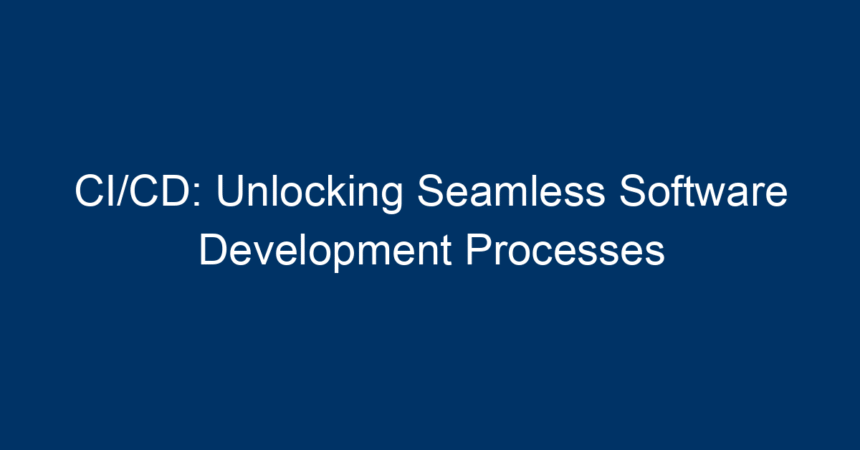In today’s fast-paced digital environment, businesses must adapt quickly to changing market demands while delivering high-quality software. This is where CI/CD comes into play, revolutionizing the software development lifecycle. CI/CD—standing for Continuous Integration and Continuous Deployment—enables teams to automate and streamline their development processes. By embracing CI/CD, organizations can improve collaboration, reduce time-to-market, and enhance product quality. In this article, we’ll explore what CI/CD is, its benefits, key practices, and how to successfully implement it in your organization.
What is CI/CD?
CI/CD refers to a set of practices and methodologies that aim to automate the software development lifecycle.
Continuous Integration (CI)
Continuous Integration is the practice of automating code changes and integrating them into a shared repository multiple times a day. This allows developers to catch issues early in the development process, leading to a more stable and reliable codebase.
Continuous Deployment (CD)
Continuous Deployment goes a step further by automating the deployment process. After the code passes all tests, it is automatically deployed to production, allowing for rapid delivery of features and fixes to end-users.
Together, CI/CD forms a cohesive strategy that enhances collaboration, improves quality, and accelerates delivery. But how exactly does this transformation take place?
Benefits of Implementing CI/CD
1. Faster Time to Market
With CI/CD, development teams can release features and updates much faster. Automating the build and deployment process streamlines development, allowing teams to focus more on coding rather than manual tasks. Organizations can adapt quickly to customer feedback and market requirements, giving them a competitive edge.
2. Improved Code Quality
CI/CD integrates automated testing into the workflow, allowing teams to catch bugs and issues earlier in the development process. Continuous testing ensures that only high-quality code is deployed, leading to fewer defects in production.
3. Enhanced Collaboration
CI/CD fosters a culture of collaboration between development and operations teams (DevOps). By breaking down silos, teams can work together more effectively, leading to improved communication and better project outcomes.
4. Reduced Risk of Deployment Failures
Since CI/CD incorporates automated testing and monitoring, the chances of deployment failures are significantly reduced. If an issue arises, the immediate feedback loop allows teams to address it quickly, minimizing downtime.
5. Consistency and Reliability
Automating repetitive tasks improves the consistency and reliability of the development process. CI/CD pipelines ensure that every code change is built, tested, and deployed under the same conditions, leading to predictable outcomes.
Key Practices for CI/CD
1. Version Control Systems
Using a version control system (VCS) is crucial for CI/CD. Git, for example, allows teams to manage changes to the codebase effectively. It facilitates collaboration, making it easier to track modifications and resolve conflicts.
2. Automated Testing
Automated testing is paramount in a CI/CD pipeline. Implement unit tests, integration tests, and performance tests to ensure code quality. Testing early and often minimizes the risk of bugs reaching production.
3. CI/CD Tools
Leveraging tools like Jenkins, CircleCI, GitLab CI/CD, and Travis CI can significantly enhance your CI/CD pipeline. These tools automate workflows, making integration and deployment seamless and efficient.
4. Build and Release Automation
Automating the build and release process helps ensure that your software is always in a deployable state. This means that each code change can be tested and prepared for deployment immediately.
5. Monitoring and Feedback Loops
Incorporating monitoring tools allows teams to collect data about application performance and user behavior. Continuous feedback helps drive improvements and iterations, making the development process more responsive.
Implementing CI/CD in Your Organization
Step 1: Assess Your Current Workflow
Before implementing CI/CD, evaluate your existing development processes. Identify bottlenecks and areas where automation could add value.
Step 2: Choose the Right Tools
Select CI/CD tools that align with your team’s needs. Consider usability, integration capabilities, and support for multiple programming languages.
Step 3: Build a CI/CD Pipeline
Develop a CI/CD pipeline that automates your build, test, and deployment processes. Make sure it incorporates all necessary stages, from coding to monitoring.
Step 4: Start with a Pilot Project
Instead of rolling out CI/CD across the entire organization at once, start with a smaller pilot project. This allows you to refine your processes and learn from any challenges that arise.
Step 5: Train Your Team
Ensure that your team is well-versed in CI/CD practices. Provide training sessions and resources to help them understand the principles of continuous integration and deployment.
Step 6: Gather Feedback and Iterate
Continuous improvement is a cornerstone of CI/CD. Collect feedback from your team and stakeholders regularly, and adapt your processes as necessary.
Real-World Case Studies
Case Study: Netflix
Netflix is a prime example of an organization that successfully utilizes CI/CD. By embracing continuous integration practices, Netflix deploys thousands of code changes daily, ensuring rapid updates and feature releases. Their approach emphasizes automation and real-time monitoring, contributing significantly to their success.
Case Study: Amazon
Amazon employs CI/CD principles to streamline its software development lifecycle. The company uses automated testing and deployment to push updates quickly and efficiently, minimizing downtime and enhancing customer experience.
Challenges in Implementing CI/CD
While CI/CD offers numerous advantages, it also presents challenges. Resistance to change is common, as teams may be accustomed to traditional development methodologies. Additionally, selecting the appropriate tools and ensuring seamless integration with existing systems can be daunting. However, the long-term benefits of streamlined workflows, improved collaboration, and enhanced software quality far outweigh these challenges.
Conclusion: Embrace CI/CD for Modern Development
CI/CD stands at the forefront of modern software development, enabling teams to deliver high-quality applications faster and more reliably. By adopting CI/CD practices, organizations can enhance collaboration, reduce time-to-market, and improve product quality. As the digital landscape evolves, companies that embrace CI/CD will unlock seamless development processes and set themselves up for long-term success.
Actionable Insights
-
Start Small: Begin your CI/CD journey with a pilot project to understand the nuances of implementation.
-
Invest in Training: Educate your team about CI/CD principles and tools to ensure a smooth transition.
-
Measure Success: Continuously monitor your CI/CD pipeline’s performance using metrics such as deployment frequencies, lead time for changes, and change failure rate.
- Iterate and Improve: Use feedback to refine your processes and adapt to changing project needs.
By following these insights and embracing CI/CD, your organization will be well-equipped to tackle the challenges of modern software development and stay ahead of the competition.




